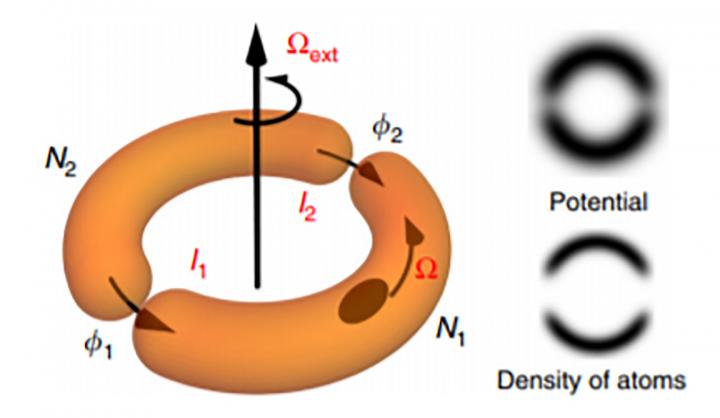Clouds of supercooled atoms offer highly sensitive rotation sensors and tests of quantum mechanics

Credit: Los Alamos National Laboratory
LOS ALAMOS, N.M., July 16, 2020–A new device that relies on flowing clouds of ultracold atoms promises potential tests of the intersection between the weirdness of the quantum world and the familiarity of the macroscopic world we experience every day. The atomtronic Superconducting QUantum Interference Device (SQUID) is also potentially useful for ultrasensitive rotation measurements and as a component in quantum computers.
“In a conventional SQUID, the quantum interference in electron currents can be used to make one of the most sensitive magnetic field detectors,” said Changhyun Ryu, a physicist with the Material Physics and Applications Quantum group at Los Alamos National Laboratory. “We use neutral atoms rather than charged electrons. Instead of responding to magnetic fields, the atomtronic version of a SQUID is sensitive to mechanical rotation.”
Although small, at only about ten millionths of a meter across, the atomtronic SQUID is thousands of times larger than the molecules and atoms that are typically governed by the laws of quantum mechanics. The relatively large scale of the device lets it test theories of macroscopic realism, which could help explain how the world we are familiar with is compatible with the quantum weirdness that rules the universe on very small scales. On a more pragmatic level, atomtronic SQUIDs could offer highly sensitive rotation sensors or perform calculations as part of quantum computers.
The researchers created the device by trapping cold atoms in a sheet of laser light. A second laser intersecting the sheet “painted” patterns that guided the atoms into two semicircles separated by small gaps known as Josephson Junctions.
When the SQUID is rotated and the Josephson Junctions are moved toward each other, the populations of atoms in the semicircles change as a result of quantum mechanical interference of currents through Josephson Junctions. By counting the atoms in each section of the semicircle, the researchers can very precisely determine the rate the system is rotating.
As the first prototype atomtronic SQUID, the device has a long way to go before it can lead to new guidance systems or insights into the connection between the quantum and classical worlds. The researchers expect that scaling the device up to produce larger diameter atomtronic SQUIDs could open the door to practical applications and new quantum mechanical insights.
###
Publication: Quantum interference of currents in an atomtronic SQUID, C. Ryu, E. C. Samson, and M. G. Boshier, Nature Communications, DOI: https:/
Funding: Los Alamos National Laboratory’s Laboratory Directed Research and Development program
About Los Alamos National Laboratory
Los Alamos National Laboratory, a multidisciplinary research institution engaged in strategic science on behalf of national security, is managed by Triad, a public service oriented, national security science organization equally owned by its three founding members: Battelle Memorial Institute (Battelle), the Texas A&M University System (TAMUS), and the Regents of the University of California (UC) for the Department of Energy’s National Nuclear Security Administration.
Los Alamos enhances national security by ensuring the safety and reliability of the U.S. nuclear stockpile, developing technologies to reduce threats from weapons of mass destruction, and solving problems related to energy, environment, infrastructure, health, and global security concerns.
Media Contact
James Riordon
[email protected]
Original Source
https:/
Related Journal Article
http://dx.




